Engine and Chassis
The first OSCA was given the model designation MT4. The “M” stood for Maserati and the “T” for Tipo. The number four, as in pre-war Maserati nomeclature, indicated the number of cylinders.
The design, completed in April of 1948, reflected the Maserati brother’s line of thought established while still with the Orsis. Like the A6G (G for Ghisa, or cast iron), the new four was also cast in iron. The aluminum head housed a single overhead chain driven camshaft which operated short rocker arms for the exhaust valves and pushrods for the intake, creating a hemispherical combustion chamber. This too, was almost identical to the first SOHC post war Maserati. The OSCA engine was notable for the lack of a head gasket, deemed unnecessary as the surfaces of the block and head were so finely lapped.
Two DPR3 Webers fed the cross flow head.
A five main bearing crankshaft, although beautifully forged, used bearings poured in bronze shells, despite the already widespread use of Vandervell’s Thinwall shell bearings. The distributor was mounted at the right hand corner of the block and magnetos supplied the voltage. Initially, the bore measured 70mm with a 71mm stroke, adding up to 1092cc and 72 hp at 6000 rpm. Mated to the engine was a four speed gearbox, with Fiat gears in a housing cast by OSCA. The semi-floating live rear axle was an OSCA product.
The development of the OSCA MT4 engine proceeded as follows:
1092cc SOHC 90 hp 1947-50
1092cc DOHC 92 hp 1950-56
1342cc DOHC 100 hp 1951-53
1452cc DOHC 120 hp 1954-57
1490cc TN 130 hp 1955-56
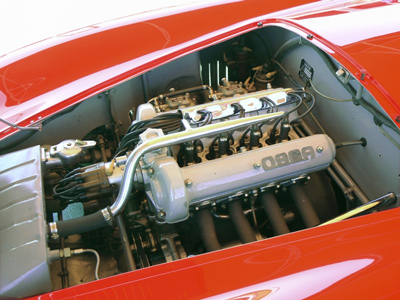
Grosseto's OSCA engine is a DOHC Tipo Nuovo with the twin plug head, rated at around 130hp. Photo by Jim Cohn.
|
The MT4 Chassis
The MT4 chassis consisted of a tubular ladder type frame which supported semi-elliptic springs attached to the rear axle. Later OSCAS would use quarter elliptics with locating rods, until the advent of coil springs in 1955-56. Like Ferrari, the Maserati brothers were engine men, not suspension engineers. Double wishbone coil spring suspension was employed at the front. The wheelbase for early MT4s was 90.55 inches, and the track was 47 inches in front and 45.2 inches at the rear. In 1953 the wheelbase decreased to 86.6 inches. Steering was worm and sector, but very accurate. Sixty spoke 3.50x15 inch Borrani wire wheels completed the chassis. It weighed just under 1000 lbs.
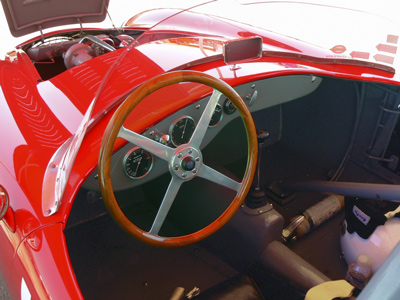
The wheel seems very upright for such a beautiful barchetta body, and dominates the cockpit of Grosseto's OSCA. Photo by Jim Cohn.
|
Over this first chassis, Tipo MT4, number 1101, was a simple, right aluminum body with removable fenders, allowing the car to participate in the Formula Two events of the era. It is important to note here, that the Maserati brothers were perfectionists, and all OSCAs would be hand built to exceedingly high standards, setting them apart from almost all other race car constructors, including Ferrari.
It would be pleasant to relate the new 1100cc OSCA as victorious on it’s maiden run at Pescara on August 15th, 1948, but Franco Cornacchia retired and repeated the failure at Stella Alpina the next weekend. For the important Grand Prix of Naples on September 19th, the Maserati brothers called upon their old friend “Gig” Villoresi, one of Italy’s finest drivers. The early teething problems were resolved and Villoresi went on to win.
But it was just the start for the firm. Between 1948 and 1967, MT4 models alone won over 400 class wins or overall victories in Italy, France, Germany and the United States.
By 1950, the SOHC gave way to a new double overhead cam head, and it was designated the 2AD (Albie Distribuzione). Following earlier practice, small followers called “linguette” (fingers) were placed between the valve stems and camshaft lobes. This reduced side loading on the valves and facilitated adjustment.
The 2AD used a double chain to drive an idler gear from the crankshaft, while the camshafts were driven off the idler by straight cut gears. As the 2AD was developed, the center idler gear drove a found mounted distributor rather than the side mounted unit. Sidedraft DCO Webers improved the induction and the 1100cc 2AD was good for over 80 hp. The new head made all previous OSCAs obsolete and within a very short time, most, if not all, existing OSCAs were modified with the twin cam head.
MT4 1500 TNs
All too aware of the increasing competition in the 1500cc class, the displacement was increased to 1491cc in 1953. Nice, but not enough, as OSCA met Porsche in the 1954 Mille Miglia, and lost. Read "When OSCA met Porsche". For 1955, the TN, or "Tipo Nuovo" was developed, featuring a twin plug head, and a dual Marelli distributor driven off the camshaft. The first twin plug head engine was installed in a special streamliner built for Jim Simpson, chassis number 1159. Confusingly, the TN nomenclature was first used as a tag to the new engines, but later was applied to a number of chassis as well, indicating a significantly revised chassis with coil spring rear suspension. The old OSCA gearbox was replaced with a new ZF unit from Germany. The 1500 TNs were to be the last of the long and successful line of MT4 OSCAs.
It was at this time, on June 17, 1955, that our feature car, John Grossetto’s MT4 TN, chassis number 1164 was assembled. Probably the third TN built, it was a red spyder, bodied by Morelli.
MT4 Coachwork
The first OSCAs were cycle fendered “siluros” (torpedo) followed by envelope bodied spyders with a low cut cockpit, removable fenders and headlights positioned behind a large oval grille. As participation in the Formula Two events decreased, a semi-avvolgente (semi-envelope) style was developed. Almost all of the early bodied cars were modified with semi-or full envelope bodies, only one or two remain untouched.
The famous OSCA body style familiar to most enthusiasts was ordered by Alfred Momo of New York, and sold to SCCA driver Bill Spear. It was delivered to him just prior to the Waktin’s Glen race on September 21st, 1952. Spear’s OSCA was the third to have been imported into the United States, the first being Rees Makin’s cycle fendered siluro followed by Randy McDougal’s semi-envelope model. While McDougal’s car had the headlights behind the grille, Spears OSCA featured headlights faired into the front fenders. A year before, a small coachbuilder by the name of Coriasco had done the same treatment to the front of Giulio Cabianca’s OSCA, but the results were not as dramatic as the changes wrought by OSCA’s own panel beaters.
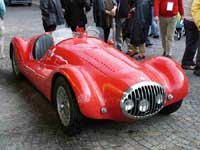
OSCA second body style, the semi-avvolgente (semi-envelope)style. Very rare today as most were rebodied before their long competitive life was over. Photo by Alessandro Gerelli.
|
Deftly, perhaps without even too much thought, the craftsmen at OSCA had successfully integrated near perfect circles into what is a rectangularly shaped object. Repeating the circular theme of the grille were the round headlights, mounted at the tip of smoothly rounded fenders. The barrel-shaped hood and scuttle complimented the grille, while at the rear was a series of gently rounded curves. Spear’s car, in addition to winning the Queen Catherine Cup in its maiden outing, set the pattern for almost every other OSCA built until the introduction of the Morelli-bodied 1500s of l955.
Despite wishes to the contrary, most of the OSCA bodies built prior to 1955 were constructed at the factory. Design was a product of evolution, and consensus among the brothers and the craftsmen. But by 1953, they realized that their small body shop could not keep up with demand. The bodies took 300 man hours to fabricate. The brothers demanded quality workmanship and loathed the thought of farming out coachwork.
There was also the issue of cost and logistics. Fru, Motto, Vignale and Coriasco were all located in Turin. A partial solution came from Francesco Giardini who persuaded the Morelli brothers of Ferrara, to rebody his OSCA in 1953. Impressed with the Morelli workmanship, and relieved that Ferrara was only a few kilometers away, the Maserati brothers signed a semi-exclusive contract for the construction of OSCA bodies. Soon, OSCA bodies would constitute 90 percent of all Morelli business. Nevertheless, OSCA kept building bodies. Of the 78 MT4 chassis built, Frua bodied 3, Vignale 4, and Morelli 25. One chassis was delivered to a customer who built his own body, and another chassis became the streamlined record car. The remaining 44 MT4s were bodied at the factory.

|
 The Morelli "Whale" of 1955. Most Morelli-bodied
OSCAs were less extreme, however. Photo by Alessandro Gerelli.
The Morelli "Whale" of 1955. Most Morelli-bodied
OSCAs were less extreme, however. Photo by Alessandro Gerelli.
|
Morelli Bodied TNs
The introduction of the “TN” in early 1955 coincided with the use of Morelli as the primary coachbuilder. Longer, lower bodies appeared, most severe being the “Whale”, for it’s long snout and slightly finned rear fenders. Later Morelli bodies were more conservative, many reflecting the lines of the 1955-56 Ferrari sport racers. Throughout this the wheelbase remained the same. TNs were campaigned successfully in the U.S. by Jim Kimberly and in Italy by Eugenio Castellotti, who easily defeated the Lotus 1500s at Imola in 1956.
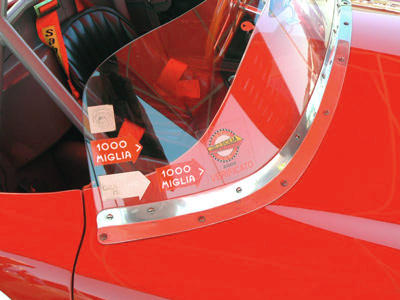
Grosseto's OSCA has been all over the world and back. Photo by Jim Cohn.
|
History of 1164
Chassis 1164 is a rare item. For, it’s history, although complete, is void of any notably of the era racing successes. It was imported new by Harry Allen Chapman, the east coast distributor for OSCAs and based in Tucson, Arizona. The car was then lent to photographer/writer Ralph Poole of Road & Track, who noted happily, that the car was delivered to him behind a “monstrous, air conditioned Buick tow car, a trailer to carry the OSCA to the desert area we used for testing, and an experienced competition driver, William “Bumpy” Bell.” The road test appeared in the August 1955 issue of Road & Track. Some pertinent specs:
Price: $10,000
Test weight: 1650 lbs
Top Speed: 120 mph
0-60: 7.0 seconds
0-100: 20.0 seconds
Quarter mile: 15.7 seconds
A few days before the road test, 1164 had been raced at Bakersfield, California, and placed 10th in class, behind the Porsche Speedster driven by actor/racer James Dean. Road tester Bill Bell retired at Palm Beach in February of 1956, and it was driven in a few other SCCA events without much success, however.
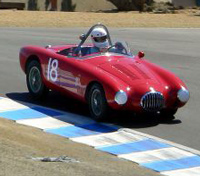
1164 in the corkscrew at Laguna, 2006. Photo by Jim Cohn.
|
Then, it’s career languished, and the car passed through several hands before being found and restored by Stephen Block and Stephen Griswold, who restored it in the 1970s. From there, it went to Allen Rosenberg, who actively campaigned the car in vintage race events.
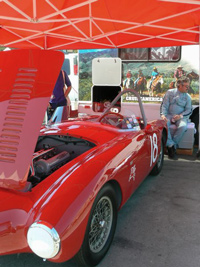
Grosseto at the rear of the OSCA, waiting his turn in practice. Photo by Jim Cohn.
|
Tom and Susan Hart then purchased the car, and it staged a second appearance in Road & Track as the salon feature in March of 1987. "Tom raced the car at Monterey in and sold it to Bill Schanbacher," says John Grosseto. "I bought it from Bill’s wife June in 1994."



